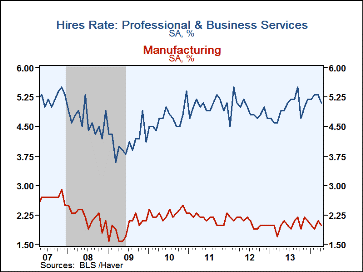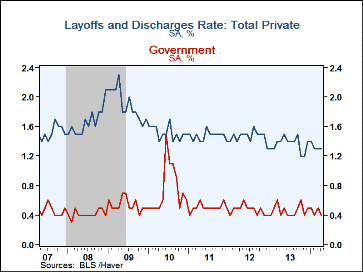 Global| Jun 10 2014
Global| Jun 10 2014U.S. JOLTS: Job Openings Rate Increases to Highest Level Since 2007
by:Tom Moeller
|in:Economy in Brief
Summary
Further indication of labor market improvement came today. The Bureau of Labor Statistics reported in its Job Openings & Labor Turnover Survey (JOLTS) that the job openings rate increased to 3.1% during April from a revised 2.9% in [...]
 Further indication of labor market improvement came today.
The Bureau of Labor Statistics reported in its Job Openings & Labor
Turnover Survey (JOLTS) that the job openings rate increased to 3.1%
during April from a revised 2.9% in March. The latest level was the
highest since September 2007. The job openings rate
is the number of job openings on the last business day of the month as a
percent of total employment plus job openings. The actual number of
job openings rose 16.5% y/y to 4.455 million.
Further indication of labor market improvement came today.
The Bureau of Labor Statistics reported in its Job Openings & Labor
Turnover Survey (JOLTS) that the job openings rate increased to 3.1%
during April from a revised 2.9% in March. The latest level was the
highest since September 2007. The job openings rate
is the number of job openings on the last business day of the month as a
percent of total employment plus job openings. The actual number of
job openings rose 16.5% y/y to 4.455 million.
The private-sector job openings rate surged to 3.4%, its highest level since September 2007 and up from the recession low of 1.7%. The rate in leisure & hospitality businesses jumped to a new high of 4.6%. The rate in professional & business services surged to 4.2%, near the recovery high of 4.3%. In the health care & social assistance sector, the job openings rate held at 3.5%. The rate in construction slipped to 1.5%, down from the 2.7% in November. In manufacturing it nudged up to 2.2%. Still lagging was the job openings rate in the government sector where it held m/m at a low 1.8%.
The hires rate held at the recovery high of 3.4%. The hires rate is the number of hires during the month divided by employment. The private sector hires rate remained at 3.8%. Amongst leisure & hospitality firms, it recovered to 5.8%. The hires rate in retail trade gained to 5.0% and in construction it improved to 4.6%, though it remained below the 6.9% rates in early-2011. In education & health services, the rate slipped to 2.7%. In the factory sector, the hires rate edged down to 2.0% and remained below the 2.5% high in late 2010. The government sector hires rate slipped to a low 1.3%.
The number of hires was stable for the second month, but they were up 5.6% y/y. Private sector hires gained 6.5% y/y as new retail trade jobs surged by more-than one-quarter y/y and hiring in professional & business services increased 8.0% y/y. Factory sector employment gained 3.8% y/y. Education & health services jobs declined 1.1% y/y but new hires in construction were off by 2.1% y/y. Government sector hiring declined 6.2% y/y.
The job separations rate held at 3.3% but the actual number of separations increased 5.1% y/y. Separations include quits, layoffs, discharges, and other separations as well as retirements. The private sector separations rate held at 3.6% for the fifth straight month and the government sector's rate ticked slipped to 1.3%. The layoff & discharge rate held at a low of 1.2% for the fifth straight month. The private sector layoff rate held m/m at 1.3% and the government's rate slipped to 0.4%.
The JOLTS survey dates to December 2000 and the figures are available in Haver's USECON database.
| JOLTS (Job Openings & Labor Turnover Survey, SA) | Apr | Mar | Feb | Apr'13 | 2013 | 2012 | 2011 |
|---|---|---|---|---|---|---|---|
| Job Openings, Total | |||||||
| Rate (%) | 3.1 | 2.9 | 2.9 | 2.7 | 2.8 | 2.6 | 2.5 |
| Total (000s) | 4,455 | 4,166 | 4,125 | 3,824 | 3,914 | 3,646 | 3,538 |
| Hires, Total | |||||||
| Rate (%) | 3.4 | 3.4 | 3.4 | 3.3 | 39.6 | 38.8 | 38.1 |
| Total (000s) | 4,708 | 4,706 | 4,699 | 4,457 | 54,139 | 52,391 | 50,264 |
| Layoffs & Discharges, Total | |||||||
| Rate (%) | 1.2 | 1.2 | 1.2 | 1.3 | 14.6 | 15.5 | 15.7 |
| Total (000s) | 1,651 | 1,574 | 1,596 | 1,700 | 20,006 | 20,979 | 20,735 |
Tom Moeller
AuthorMore in Author Profile »Prior to joining Haver Analytics in 2000, Mr. Moeller worked as the Economist at Chancellor Capital Management from 1985 to 1999. There, he developed comprehensive economic forecasts and interpreted economic data for equity and fixed income portfolio managers. Also at Chancellor, Mr. Moeller worked as an equity analyst and was responsible for researching and rating companies in the economically sensitive automobile and housing industries for investment in Chancellor’s equity portfolio. Prior to joining Chancellor, Mr. Moeller was an Economist at Citibank from 1979 to 1984. He also analyzed pricing behavior in the metals industry for the Council on Wage and Price Stability in Washington, D.C. In 1999, Mr. Moeller received the award for most accurate forecast from the Forecasters' Club of New York. From 1990 to 1992 he was President of the New York Association for Business Economists. Mr. Moeller earned an M.B.A. in Finance from Fordham University, where he graduated in 1987. He holds a Bachelor of Arts in Economics from George Washington University.








